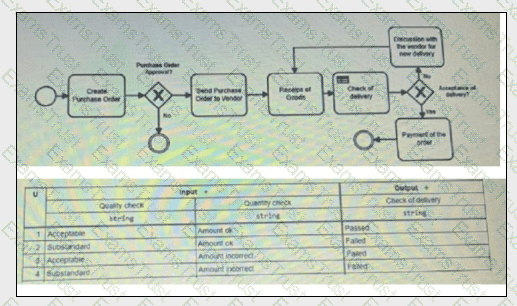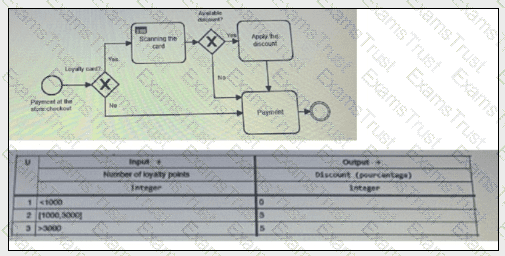Which one of the following arguments is the BEST reason to add additional information to BPMN diagrams?
Which one of the following statements regarding ATDD / BDD is true?
Which one of the following statements describes the relation between business goals, business needs and requirements BEST?
Which one of the following statements describes correctly how acceptance testing may be augmented with other test techniques or approaches?
Which one of the following scenarios characterizes UX task analysis BEST?
Which of the following provides the BEST description of Beta testing?
Consider the following BPMN model and the related DMN model describing the decision rules associated to the "Check of delivery" activity
What is the minimum number of test cases required to cover all paths without repeated loops in the BPMN model AND all decisions in the DMN table?

During usability testing, the ergonomic of the products shall be checked. Which one of the following usability testing techniques matches this test objective BEST?
Which of the following is the BEST example of a Gherkin-style test for a web-based banking application?
As an acceptance tester you are analyzing the following user story for a computer web-based mass multiplayer role-playing game:
As an unregistered player
I want to be able to register myself by defining my e-mail, login and password in a registration form so that I become a registered player
Consider the following propositions of the acceptance criteria:
i.a registration form is displayed on the screen.
ii.the form is written in the Groovy language; the cursor is initially set on the ‘login’ field; after pushing the TAB button the cursor switches to ‘password’, ‘repeat password’, ‘mail’, and ‘repeat mail’ forms.
iii.I cannot register myself if the login I choose is used by another player.
iv.after successful registration process I am informed about it by an e-mail.
Which of the above statements would you consider as well-written acceptance criteria?
Which of the following information is most likely part of an acceptance test summary report?
For a project to migrate an employee qualification management system to web technologies, the following requirement has been defined REQ 3-12
The system must be able to manage 3 types of users: HR team member with full rights, department manager with consultation and update rights only for members of his/her department, and employee with read-only access to his/her data
Which of the following sentences BEST reflects an acceptable acceptance criterion?
Which one of the following test design techniques fits accepting testing purposes BEST?
The following BPMN and DMN models are used for acceptance testing. The DMN table is linked to the credit card scanning to check if a discount is applicable.
Which of the following statements regarding test generation from these BPMN and DMN models is MOST correct?

Which of the following statements about test approaches and test techniques for acceptance testing is MOST correct?
Which one of the following scenarios is MOST likely to be encountered in the context of performance testing?
Which of the following statements regarding defects is MOST correct?
As a tester on an Agile project, you have to perform an exploratory test session for a new feature developed. Which of the following actions is the LEAST likely to be carried out for the purpose.
In Agile an exploratory test session is conducted. Which one of the following concepts applies BEST?
Which TWO of the following statements about exploratory testing are most true?
Which of the following activities is most likely performed by the business analyst as part of defect analysis?
Which one of the following statements about the relation between business goals, business needs and requirements is true?
On a project to develop an event booking platform, a review session is being conducted on acceptance test cases written in Ghenkin's language. Consider the following test case:
1. GIVEN I am logged in on the event booking platform
2. AND I have selected an event from the list displayed for the "live concert" category
3. WHEN I click "Buy Tickets" buttom
4. AND I enter "3" into "Ticket quantify" field
5. AND I agree on terms and conditions
6. THEN The system should display the checkout page
7. AND I should provide my personal data for payment and eticket delivery
Which of the following sentences MOST closely corresponds to a comment that could be made on this test case during the review?
How does ISTQB CTFL test activities relate to the IQBBA FL business analysis and requirements engineering activities?